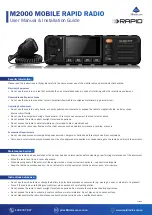
ERE Stradella Italy DL169-IN-B
4
Starting use:
The
DL169
device is delivered with the following
default configuration
:
♦
169.40625
channel radio in
broadcasting mode
, transparent to the user.
♦
9,600 bps UART
Data Rate,
8
,
N
,
1
format,
No Flow Control
and
448 Bytes
Buffer size
♦
4,800 bps Radio
Data Rate with
12,5 kHz
canalisation
♦
RF Output Power
of 200 mW
The device, if is not required a specific configuration, may be immediately utilised connecting it to a RS 232 or RS 485 serial
interface of dedicated DTE ( PC, RTU, PLC or other ) .
The device configuration may be done by the
Configuration Software DL148SW-IN
, available for free download from our
website, and the internal
Help
shows all the necessary information on the software utilisation and configuration parameters.
Detailed information about the device protocol are available in the
DL148Pro
file , available, as the previous, from our website.
Special functions:
LBT – Listen Before Talk
– If enabled, before the transmission of a packet, the radiomodem checks the status of the operating
channel by a period of 5 milliseconds and ,only if the channel is free for all this period, the transmission start. The free/busy
threshold is set to –103 dBm for 12,5 kHz canalisation and to –100 dBm for 25 kHz canalisation in according to the European
directives. If during the checking period the channel status changes from free to busy condition, the radiomodem reset the
procedure and it restart when the channel come back to free condition. The incoming data to transmit is stored in the internal
buffer until the radiomodem can transmit it, so the Flow Control option must be enabled to stop the next incoming data from
DTE.
AFA – Adaptive Frequency Agility
– In the configuration process is possible to select 1, 2 or 3 channels as above specified.
When more than 1 channel is selected the AFA mode automatically starts, so the radiomodem scans the selected channel and
transmit on the less interfered one. If also LBT is enabled, the LBT thresholds are used to define the free channel and the unit
transmit on this one.
Using the LBT and AFA the
Duty Cycle limits
of the European directives
can be exceeded
.
Of course, if these functions are selected,
all
the units in the communication network
must be configured
with these functions
to allow the communication process because the improvement of the reliability of the communication is obtained lengthening the
preamble time. If, normally, the preamble times are of 8.35 and 5.83 milliseconds respectively for 12.5 or 25 kHz canalisation,
they become of 25 or 20.75 milliseconds for two channels and of 36.74 or 30.71 milliseconds for three channels.
DUTY CYCLE
: If it is not used the LBT+AFA function the Duty cycle mediated on the hour must be respected (10% metering
& commands, 1% tracking and tracing).
PWSAVING
-
The
Power Saving
function allows a considerable energy saving in all situation where the device is feed by a
battery or solar cells and, of course, this saving is obtained lengthening the transmitting periods. This may have the appearance of
a nonsense, but the maximum amount of energy is spent in the receiving status because the transmitting mode is normally shorter
than the receiving one. In the Power Saving mode the
ON
time of the unit is internally set to
13
or
10 milliseconds
, respectively
for 12.5 or 25 kHz of canalisation, while the
OFF
time can be set in configuration in
10 milliseconds
step. The
preamble time
length
is
increased
by the selected
PwSavOFF
time and, of course, this time
must be the same
in
all units
of the com-
munication network. An incoming preamble from radio and/or an incoming data on the serial port exits the unit from the Power
Saving condition and it stays in the normal operative condition until the selected
PWSava time
is expired. During the
PWSava
time the radiomodem utilises a normal length preamble so the answer can be transmitted in the allowable shortest time.
The
PWSava time
can be selected in the
100 milliseconds
to
25,400 millisecond
range. The value
PWSava = 255
keeps the
unit
always operating
but the generated preambles have a length defined by the selected
PwSavOFF
time. This feature may be
useful when the Master unit and the digipeaters, if presents, are supplied by the Main to allow the decoding of both short or long
preambles. The PWSava time can modify the total amount of supplied energy, so its correct choice is fundamental for the better
results. For detailed information please refer to the
Configuration Software Help an the protocol description.
Att.!! the maximum time of transmission in order to respect the norm EN 300 220-1 v2.1.1 is
≤
1 sec.





























